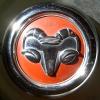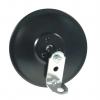-
Posts
5,720 -
Joined
-
Last visited
-
Days Won
61
Content Type
Links Directory
Profiles
Articles
Forums
Downloads
Store
Gallery
Blogs
Events
Classifieds
Posts posted by JBNeal
-
-
I reckon that's the nature of the beast, finding how to get all of the bolts out with the least amount of work. Since this beast has been sitting in the woods for all these years, it might have to bite the bullet & pull the engine+trans as a unit for cleaning & replacing the gearbox seals. At the very least, the transmission will have to be removed to get at those remaining flywheel bolts. Jacking up the front of the truck a foot or two should give enough room to get a floor jack (and adapter) under the transmission to guide it off the pilot bushing, but the driveshaft will need to be removed.
fwiw, I've resurrected two Pilot-House trucks from being parked outside for 20+ yrs...getting the '48 road-ready was an extended chore and taught me patience with each busted bolt & knuckle, so when I tackled the '49, I was ready for each hurdle that I had to cross. This also gave me the confidence & patience to split my International 584 to replace leaking engine seals & a fried parking brake. They are all machines that can be worked on if'n ya take yer time and accept the workload that is required to get the job done.
-
Yep, thinned oil won't provide enough protection...as I was taught by a few older mechanics, developing a feel for oils & greases is a skill that can be used in diagnosing problems. My Firestone co-workers wondered why I wiped the dipstick with my fingers instead of a rag when doing oil changes, and this is why. Oil may look okie dokie, but if it doesn't feel right, then there's a problem afoot that needs attention.
When I first got the '48 running back in '96, I had not rebuilt the fuel pump or distributor. This was my first engine rebuild, and being in college, I didn't have much $$$ for the peripheral stuff, so I focused on the engine internals, starter/generator, and carburetor. The truck had sat in the TX sun, heat & humidity for 20+ yrs, and I was about to learn alot about that. The engine ran fine for about a day, then the fuel pump diaphragm came apart. When I rebuilt that, I reckon that AC pump dated from the 60s. When I got it on the road after fixing the brakes, it ran like carp going up hills and couldn't go over 30mph. That's when I realized the distributor vacuum advance had come apart. So I parked it for another 2 yrs while I replaced every rubber component on that machine when I could scrape up the $$$ as I was now assuming they were all very close to being rotten.
With the advent of the E10 gasoline blends that are prevalent, this only magnifies the need for replacing all rubber fuel components on these old buggies. I've spied a few vintage NOS fuel pumps on eBay and I know they will need a rebuild kit to update the rubber parts, so I stay away from them. I found several Power Punch ring sets on eBay, and one set had little pock marks in the auction photos so I stayed away from those as I was certain that the seller had cleaned off some oxidation but didn't get all of it.
IMO I think your bearings were going to fail from the oxidation that had occurred before installation, but the oil dilution accelerated this failure.
-
One of my concerns on my '48 is the inner bearing race that could be removed from the axle housing with my pinky finger, that seemed just a tad too loose to me as the left side was a bit more snug. At the 5000 mile mark, I had gear oil in the axle bearings, first spotted when gear oil was on the backing plates accumulating gravel road dust. I cleaned all that up and put another 5000 miles on the beast, same result: a very slow seep of gear oil into the axle bearings. I don't recall any shims being present, so I reckon that's gonna need to be addressed; anyone know the thicknesses I should make or a supplier? I'm kinda thinkin' that there's a slight neck on my axle shafts that is allowing the gear oil to get past the inner seals, dunno if that can be sleeved or not.
Anyhow, just wonderin' if anyone had run into the loose race issue. I'm not sure if I can make a 'sleeve' for the race/axle housing since I don't know the exact ID of the housing. When I tear the '48 apart in a few weeks, this is one of my priorities to address as I don't want to be motoring into town someday and lose a wheel to a busted axle shaft.
-
Gasket paper from your local auto supply store and a few minutes with scissors/shop knife and some hole punches. For my usage pattern, the hole punches from Harbor Freight are of sufficient quality and were pretty cheap.
I've used this approach many times...my shortcut is to put a thin thin layer of grease on my flat machined surface, then mash that surface onto the gasket material. It will leave a silhouette for cutting the new gasket.
For assembly, I use gasket sealant to stick the gasket on the surface for assembly. So far, those homemade gasket haven't seeped any.
-
Remove as much of the crud with a screwdriver, gasket scraper, steel brush, etc. as ya can so ya can use the least amount of chemicals possible. Heating up old caked-on gummy grease will get it more fluid to scrape. I've soaked parts in vinegar with success, then poured the waste on the gravel driveway weeds to knock them down too. Diesel, an old stiff nylon paintbrush & a bucket were good also...place the bucket under your work area so you can brush the diesel on the parts and it'll drip back into the bucket...if you're really good at it, none of the diesel will miss the bucket. Once all those heavy deposits are off, any of those degreasing chemicals will work great at attacking the crud that's in the 'pores' of the metal.
-
how'bout some of that roll-on bedliner stuff, for the sound insulation?
-
the 5-digit odometer should be a giveaway...from what I've been told, if ya could make a car or truck last 80k, then that was due to good maintenance and minimum wear & tear. Counting all the grease zerks and adjustments that could be made on brake & suspension parts, as well as carb & clutch rebuilds, vehicles of that era usually pooped out before the motors did.
-
I've seen a Chevrolet version of one of these (in a photograph), complete with the roof rack & visor...I'm thinking it's a limousine or school bus up-fitted as a limo.
-
an alternative is to put the float in the summer sun and let the accumulated gas boil out, then re-solder the joint. Test by attaching a weight like a big hex nut on a string to the float and submerge the float in a pot of water. Any air in the float will find the leak point as bubbles would escape, much like finding a pinhole in a flat tire. Submerge for I dunno a day or so to test the solder joint.
-
I reckon the oil pressure switch can also be routed to a relay that feeds the ignition coil...a manual override switch with a trigger guard could be put under the dash.
-
Q: if an electric fuel pump is installed, does a return line from the carb to the fuel tank also need to be installed? My concern is the psi from the electric pump will crack open the float needle valve and flood the carb...
-
The electric fuel pump as a back-up to the mechanical fuel pump as well as a mfp primer...I reckon that is going on the upgrade list, along with bigger rectangular mirrors, radial tires & turn signals.
My '48 stalled a couple of summers back at the controlled intersection of two farm highways in between two small towns. As I sat in the truck at the green light, waving the sporadic drivers to pass, I spied a rapidly approaching F250 with a contractor just a yappin' on his cell...I was getting ready to bail out of the truck when he finally saw me stopped in the middle of the road and swerved to avoid smashing into me. This prompted me to get out & push the beast into the ditch, where we sat for another 1/2 hour (it was well over 100 that day) as the truck cooled off, both hoods open. I reckon the electric fuel pump would've negated this story and the near-loss of my wits that day, so that's good enough reason to bite the bullet.
-
Sounds like the float needle valve is sticking open, allowing the fuel pump to flood the carb. Ya might have some crud in the carb, as sediment & varnish have a tendency to collect in the float chamber. I recommend removing the air horn, being careful not to damage the gasket, remove the float & needle valve, and flush the innerds with a can of aerosol carb cleaner. Dry with compressed air, reassemble to specifications, and see if that works. Or go the full nine yards and get a carb.kit, disassemble the carb from air horn to mounting flange, clean thoroughly & reassemble.
-
I recall the shop manual mentioning removing the front fenders & grille shell as a unit. If you've got an engine hoist, you could probably do this by using some 2x4s & lifting straps. If you've got the floor shifter, remove the top plate from the transmission to clear the cab firewall after removing the floorboards. Then the engine/transmission can be unbolted from the frame, tilted up, pulled forward, raised and removed for further entertainment.
-
I have '51, '52 & '53 parts trucks that I'm planning on cobbling together to make a driver with the T-5. The '52 is the most intact, but it has the B-1 grille, hood & baffle. Does anyone have a picture of the B-3 baffle? I might have to fabricate one, but this project is on standby until after I get the '48 & '49 back in shape.
-
I found a 18 wheeler mud flap in the road one day, it was chewed up but I was able to take a hacksaw to it & cut a rectangle about 3" x 6", I reckon that stuff was about 3/8" thk. Some 1/2" x 2" bolts oughta be long enough to cinch that all together.
-
4WIW, the radiator in my '48 is thought to have come out of a much older Pontiac. That radiator had a center fill neck that had been removed and patched over, with the Dodge neck attached in the driver side of the upper tank. The Dodge mounting brackets had been grafted to the sides of the Pontiac, and it fit, barely. That radiator sat high in the engine compartment, with the tank less than an inch lower than the hood.
I would not be surprised if these high sitting radiators were skillfully transplanted from some other vehicle back in the day when it was cheaper to fix stuff than to buy a replacement. I recall an old local garage commercial where these two knuckle-draggers would say "we'll make it fit"...
-
the ceramic coating absorbs heat so slowly that the heat in the exhaust gases escapes the manifold before significant heat exchange takes place. Aluminized exhaust pipes are similar in that they absorb heat slowly, but since aluminum is ductile, the pipes can be formed without damaging the surface coating.
-
Tractor dealers & suppliers sell the 2/0 cable by the foot, solder lugs can be ordered too. That pre-packaged battery cable at AutoZone is 4 gauge, about half the diameter that the 6 volt system requires.
-
A trick I learned when I lost 2 center caps off of my Dakota was to put RTV on the cap where it contacts the wheel/clip. I've also done this with my '02 Ram 2500 CTD 4x4 center caps after losing one of those li'l jewels. It appears the RTV doesn't glue the cap on as much as it fills the voids between the cap & the wheel/clip, vastly minimizing vibrations that would shake the cap loose. It's cheap, simple, and can be cleaned off & re-applied with new when servicing. IMO, it seems like it's harder to pry the caps off of the wheels because the cap doesn't want to pop off, it has to be worked loose to be removed.
-
When I got my '48 road-worthy, it was all over the road as the bias ply tires reacted to every lump & dip in the road; I quickly opted to limit my speed to under 45mph to keep from wandering into the ditch or into oncoming traffic. I did find that when I had about 1000# in the bed that the ride smoothed out considerably. After that load was removed, the rear seemed a li'l more under control, probably because the load had worked the springs loose after they had sat dormant for 20+ yrs. I spray those rusty leafs every spring and put a load on to work the springs loose.
By comparison, my '02 Ram 2500 CTD 4x4 has a solid front axle, and WOW is that truck a handful compared to a 1/2 ton longbed. It's much smoother than the '48, but it's still a chore to keep it in a straight line compared to a lighter modern truck. [steering and suspension issues were repaired, yielding a truck that rode like a dream]
Radial tires are helpful in smoothing out the ride. I've also heard of guys removing a leaf or two from their rear springs to smooth out the rear hop. New shocks would help too, so would setting the steering box & front end alignment in keeping the wheels to track straight.
The spring bushings have a grease zerk on them for a reason, and if they are frozen or worn, then it's time for new ones. I reckon if each suspension component is addressed at the same time, then you'd recognize a change in handling. But as my dad told me, it's still a 50+ yr old pickup, so don't expect it to float like a Newport on the way to town.
-
If the insulation is falling off, then the wires will probably be corroded and that will increase your system resistance. It's time to replace that harness, perhaps with a temporary one made with rubber insulation. I replaced the harness on my '48 one wire at a time, long before I got a shop manual. The wiring diagram in the shop manual shows color & wire gauge; if ya wanna further decrease resistance, bump the wire gauge up to the next size, effectively broadening the electrical path of the circuit. But the 2/0 battery cables are plenty big as long as the starter is within arm's reach of the battery.
-
With #1 @ TDC, distributor rotor should be pointing around 7 o'clock position.
If your vacuum advance was introducing a leak into the charged air, then the carb will need to be reset because it is now too rich. Turn your mixture screw all the way in, then back it out 3/4 to 1 turn. I recommend shooting a 1-2 second burst of ether down the carb with the choke open to give the fuel a little boost in the sparkability department.
-
are ya talkin' bout one of these...?




Blocking off the port on the thrmo housing
in Mopar Flathead Truck Forum
Posted
the factory cooling system ain't pressurized, so the cap shouldn't have a spring in it.
a water pump without the port for the external bypass elbow on top is for internal bypass engines. The internal bypass head will have a bump on the thermostat end of the casting, whereas the the external bypass head will be squared off on both ends. The internal bypass head will have an opening in that bump that should mate with an opening in the head. The head gasket for the internal bypass head will have a corresponding ear for this passage, whearas the external bypass head gasket has squared off edges.
btw, when I rebuilt the 218 in the '48 back in '96, I didn't realize that I had a 218 from a '53. So I have an internal bypass engine with an external bypass gasket set & housing. Now that I've realized this, I know why I have a seep behind the water pump at the head.